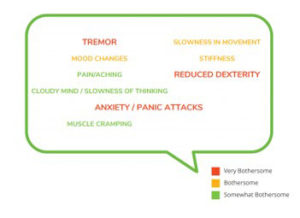While Parkinson’s can be a difficult disease for many patients to deal with, there’s now a new online tool that can help them initiate helpful—and in fact, crucial—dialogue with their health care workers.
We spoke with Karen Jaffe, MD, co-founder and vice president of InMotion, a community center for people with Parkinson’s and other movement disorders. A retired OB/GYN physician, Jaffe was diagnosed with Parkinson’s in 2007. She gave us important information that nurses need to know about the “Do Tell” Your Doctor Tool.
What is the “Do Tell” Your Doctor Tool, why was it created, and how does it work?
The “Do Tell” Your Doctor Tool aims to improve communication around “off periods” between people with Parkinson’s and their doctors. “Off periods” are the re-emergence of Parkinson’s symptoms, which can be hard to identify because they differ for each person and sometimes from day-to-day. These factors can make it difficult for people with Parkinson’s to communicate about their symptoms with their family, friends, and health care professionals.
The tool is based on a clinically validated questionnaire developed by Duke University, called the Wearing-off Questionnaire 9 (WOQ-9). Users review nine Parkinson’s symptoms and rank how bothersome each symptom is (for example, “Very Bothersome,” “Bothersome” and “Somewhat Bothersome”). After completing the questionnaire, users will receive a customized word cloud via email that visually displays the symptoms they chose, with the largest words depicting the most bothersome symptoms. They can then bring these results to their next doctor’s appointment to help guide and prioritize the discussion about their Parkinson’s symptoms.
As part of the “Live Well. Do Tell.” steering committee, my organization, InMotion, had the opportunity to participate in beta testing for the tool to ensure that it’s user-friendly.
What do nurses need to know about it?
People with Parkinson’s who experience “off periods” may not discuss their symptoms or communicate the impact to their health care professionals, as they may believe that the re-emergence of symptoms is just part of their condition, or they may rationalize the impact because they fear it signals their condition is progressing. The intent of the tool is to initiate better dialogue between people with Parkinson’s and their health care professionals about their symptoms and about “off periods.”
How can they utilize this tool or recommend that their patients use it?
If patients are having a hard time talking about their symptoms, pointing them to this tool may provide them and their care partners with a guide to recognizing and recording symptoms that may be overlooked.
The tool is an easy online resource that people with Parkinson’s can use in advance of their doctor’s appointments. With the resulting word cloud shared via email, they’ll be armed with an actionable item they can share with their health care providers, who can in turn help them better manage their Parkinson’s symptoms to live well.
Why is it important for this tool to exist? What does it provide that is new?
Many factors make it difficult for people with Parkinson’s and their care partners to distinguish their most bothersome symptoms, and many often have a hard time articulating the impact of their symptoms during a doctor’s appointment.
The “Do Tell” Your Doctor Tool can impact the care people with Parkinson’s may receive—offering a visual guide that helps to recognize and record a person’s bothersome symptoms and providing a resource they can bring to their next doctor’s appointment to spark discussion and lead to more effective communication.
The need for this kind of tool was first identified in the “Live Well. Do Tell.” Statement of Need, which serves as the foundation of the initiative and outlined actions for the Parkinson’s community to help identify and communicate about “off periods.” The Statement of Need was developed based on learnings and insights from a multidisciplinary steering committee of leaders in the Parkinson’s community who collaborated to discuss unmet needs in understanding and communicating about Parkinson’s symptoms.
The “Do Tell” Your Doctor Tool is available online at LiveWellDoTell.org/takeaction.
- What an MSN Can Do for You - October 18, 2023
- The National League for Nursing: Connecting the Academic and Clinical Worlds for 130 Years - August 16, 2023
- Treating Burnout, Trauma, and Grief with Dance - July 14, 2023




